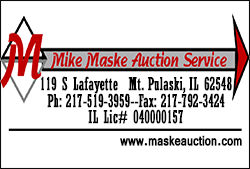|
University of Illinois Extension
Selecting Disinfectants for COVID-19
 Send a link to a friend
Send a link to a friend
[April 23, 2020]
In the midst of the novel coronavirus
pandemic, we are turning to disinfectants for help, but how do we
know if they are effective? In general, disinfectants control a wide
range of pathogens that are or could be a problem on hard, porous,
or nonporous surfaces. These pathogens may include Staphylococcus
aureus, Salmonella enterica, Escherichia coli (commonly known as E.
coli), and even some strains of the flu. Some pathogens are known
problems; some are not likely to be an issue; and others are
emerging and therefore have been unavailable to study. |
|
 The U.S. Environmental Protection Agency (EPA)
registers disinfectants for use and, as such, classifies pathogens
into three tiers: small non-enveloped viruses, large non-enveloped
viruses, and enveloped viruses. According to EPA, corona viruses are
enveloped viruses, which is the easiest tier of virus to kill with
the appropriate disinfectant product. The criteria for that
classification is based on how the three types are inactivated by
disinfectant. When an emerging viral pathogen is identified, a
disinfectant manufacturer has to provide evidence to EPA that their
particular product can be effective against the pathogen if they
wish to make pesticidal claims against that pathogen. The U.S. Environmental Protection Agency (EPA)
registers disinfectants for use and, as such, classifies pathogens
into three tiers: small non-enveloped viruses, large non-enveloped
viruses, and enveloped viruses. According to EPA, corona viruses are
enveloped viruses, which is the easiest tier of virus to kill with
the appropriate disinfectant product. The criteria for that
classification is based on how the three types are inactivated by
disinfectant. When an emerging viral pathogen is identified, a
disinfectant manufacturer has to provide evidence to EPA that their
particular product can be effective against the pathogen if they
wish to make pesticidal claims against that pathogen.

Normally, for a product to endorse a claim to kill a pathogen, it
must prove its ability to be effective against the known pathogen
with extensive scientific research, which takes considerable time.
In the case of an emerging pathogen, time is of the essence. The EPA
offers guidance to registrants on the required criteria when making
claims on emerging pathogens not previously listed on their labelon
the guide “Emerging Viral Pathogen Claims for SARS-CoV-2: Submission
Information for Registrants.”
https://www.epa.gov/pesticide-registration/emerging-viral-pathogen-claims-sars-cov-2-submission-information-registrants
The provisions allow manufacturers to be able to
request an amendment to the label by proving that the disinfectant
has provided efficacy against harder-to-kill pathogens. (For
example, Rotavirus is harder-to-kill than SARS-CoV-2). The EPA
reviews the claim to determine its safety and then can approve the
claim, thus allowing the manufacturer to make off-label claims to
the public. The scientific testing will still need to be conducted
and submitted to EPA, but this expedited process can be used to get
something in place immediately.
As many products are coming to market, the EPA has been helping
manufacturers work through the amendments and create a list of
products that can be used against SARS-CoV-2, the novel coronavirus
that causes COVID-19. EPA is referring to this list as “List N.”
When purchasing a product, consumers can check the EPA registration
number to see if it is included on the list and will therefore be
effective against COVID-19.

[to top of second
column] |

This list -
https://
www.epa.gov/pesticide-registration/list-n-disinfectants-use-against-sars-cov-2
is being updated frequently. The label and table images below are
provided as an example of what to look for. Again, refer to the
website for an up to date list.
Check the EPA registration number on the product
label. Locate the same EPA registration number on EPA’s List N.
In List N, the column that reads “Follow the
disinfection directions and preparation for the following virus”
shows Rotavirus, and the question might be asked, why doesn’t it say
SARS-CoV-2? This column lists either viruses that are another type
of human coronavirus similar to SARS-CoV-2 or viruses that are
harder-to-kill than the human coronavirus. EPA allows both. Be sure
to note the next column over. Pay close attention to the contact
time, which is the amount of time the surface should be visibly wet,
which is listed in minutes.

Before making your final selection and heading to the check out, be
sure to fully read the directions for use on the product’s label.
Special attention should be given to the contact time on the surface
that is treated so there is full effectiveness. Carefully follow all
label directions. If a product is not on the list, it has not been
qualified for use against COVID-19. Remember that disinfectants are
pesticides and the label is the law. For additional information
about using disinfectants effectively with steps to reduce your risk
while using them, review the National Pesticide Information Center
http://npic.orst.edu/ingred/ ptype/amicrob/ covid19.html
Additional References:
Environmental Protection Agency -
https://www.epa.gov/coronavirus
EPA List of Disinfectants Against
COVID-19 -
https://www.epa.gov/
newsreleases/epa-releases-list-
disinfectants-use-against-covid-19
National Institute of Health -
https://www.ncbi.nlm.nih.gov/pmc/
articles/PMC4369385/
Infection Control Today
-
https://www.infectioncontroltoday
.com/covid-19/select-effective-
disinfectants-use-against-coronavirus
-causes-covid-19
[Maria Turner, University of Illinois
Extension] |